
Having beautiful and healthy hair is something that all women want but it is not always possible. Sometimes we subject our hair to so many things (dyes, drying, straighteners, etc ...) that it ends up really damaged and the only solution seems to be a surgery-based treatment that we now explain in detail. Let's now see everything about hair surgery: what it consists of, methods and alternatives .
Although it sounds like a hair transplant, the truth is that in hair surgery we never have to take hair from another area of our body or from another person and transfer it to our head, but in reality we can compare the treatment a little when we undergo a keratin treatment, although we have to apply a product similar to the one used for keratin.
When you want to straighten your hair and you undergo the keratin treatment, they usually apply formalin on the hair (in addition to other products), but in hair surgery what is applied does not have chemicals or proteins.
In the treatment of hair surgery, we are subjected to a series of fatty acids applied to our hair that are apparently extracted from nutmeg and that deeply hydrate the hair.
In this way, we can say that hair surgery, also called capillary plastic surgery, is a treatment that allows you to recover not only the health of your hair, but also eliminates the "frizz" completely and allows you to work again with your hair as if you had never "mistreated" it with irons or dyes before.
What hair surgery involves is nothing more than a deep hydration to the hair that produces softness, resulting in a magnificent appearance of silk, shine, while highlighting its natural or dyed color.
The treatment of hair surgery is quite similar, as I have already mentioned, to that of keratin since it consists of applying the product and then working on it, but we can find different options in this regard.

The basic or the most normal thing to apply hair surgery is to apply the product on the hair so that it covers it completely. Then the hair is dried of all the moisture it has and then we pass the iron so that the liquid that we have added penetrates completely and is sealed to our hair.
If you undergo a good hair surgery treatment in a trusted beauty salon where they know what they do, we can say that you will notice the results immediately and the hair will stay shiny and hydrated for at least six months.
However, the treatment is very similar: it consists of applying the product all over the hair, drying the moisture and passing the iron so that the liquid penetrates deeply and seals in the strands. Once the treatment is done, the effects are seen immediately and can be kept for up to six months.
Hair surgery or hair plastic surgery is so extremely revolutionary that we can already find other methods on the market that have to do with the way in which the product to be applied to the hair is presented.
In this way, we can buy specific ampoules for this treatment that are dissolved in hot water and applied to the hair (previously washed with a sodium-free shampoo).
Once you have washed the hair, you must partially dry it so that it remains wet. With the help of a dye brush you should spread the mixture of the ampoule and the water. Put on a shower cap for 20 minutes so that the product is filtered and finally, pass the iron to finish sealing the hair.
On the other hand we also want to mention hair grafts and although hair surgery or hair plastic surgery has nothing to do with transplanting hair (something already mentioned and explained), many people doubt whether it is the same since the word surgery can cause us to think that it really is about undergoing a method from hair implants.
The truth is that when a hair graft is performed, hair surgery is also performed, although the method is more complex than what hair plastic surgery is. One thing is to have hair where there is none and another is to recover the beauty, density and hydration of damaged hair. The performance of the treatment also depends on the right product and what we really need. Product advertising should not get us completely hooked
After having explained what the hair surgery technique is and telling you that it can be effective to regain beautiful, hydrated and shiny hair, you may want to know other alternatives in which you do not have to subject your hair to a product (although this do not carry chemicals) and an iron. Let's see some alternatives that may also convince you when it comes to recovering the beauty of your hair.

If you are regulars at beauty salons and have undergone various hair treatments, you may be familiar with one based on argan oil, which we can say is one of the most natural that exists. In this way, it is a good alternative for hair surgery, in addition to also serving for those who do not wish to undergo keratin treatment to straighten their hair.
With this treatment you will get the hair to regain all its hydration and natural shine. Argan oil has glyoxylic acid as its main asset, which seals the scales of the hair so that it is recovered 100%.
On the other hand, if you do not want to undergo hair surgery, you can try the so-called "Moroccan treatment" for hair which consists of applying white clay, cocoa oils and silicone emulsions which create a kind of "waterproof" in the hair area. , so that all the hair proteins remain intact despite the washing and drying that we subject the hair to.
Finally, we can mention taninoplasty, which is a treatment based on tannin, a vegetable polyphenol that is extracted from grapes, as well as oak and chestnut.
It is also a natural treatment without chemical preservatives that allows hair to be fully hydrated while eliminating "frizz" and deeply smoothing it.
Natural biofibers are recommended in cases of diffuse alopecia or thinning of the hair. This technique consists of the implantation of artificial hair that has been made with biocompatible elements, which is why it is considered a totally natural material and that the body does not reject.
Unlike the hair surgery that we talked about previously, this type of treatment gives an immediate result. In order to carry out the intervention, local anesthesia is applied.
We recommend some natural alternatives for restructuring your hair naturally.
Do you know the African plum tree?
The African plum is an oral supplement obtained from the trunk of a tree called Pygeum africanum. This tree is native to the sub-Saharan region of Africa, where it is used for the treatment of prostatic hyperplasia and androgenic alopecia. The African plum works by inhibiting the hormone dihydrotestosterone, which is responsible for androgenic alopecia in both men and women. For this reason, African plum is considered a natural medicine antiandrogenic drug. Cut your tree of the African plum for to remove its leaves and make an infusion to apply a hair mask and you will see how it acts in an incredible way.
It is very likely that you have heard of mesotherapy for other types of aesthetic treatments but you know that it can also be used for hair treatment. This technique is recommended for those patients who still have hair follicles on the scalp, so that with this treatment what is achieved is to reactivate the growth cycle.
Unlike the previous one, it is not a technique that obtains results at the moment, but it is a process that requires several injections of a specific compound for the hair to be made during several sessions, in order for these substances to activate hair growth.
This treatment consists of direct micro injections of the patient's own plasma, once it has been centrifuged. PRP (is the acronym for this treatment) states that the injection of this plasma translates into an improvement in the formation of collagen, hyaluronic acid, elastin, while increasing vascularity from a follicular point of view.
This treatment, like mesotherapy, is aimed at strengthening existing hair but cannot regenerate bald follicles. Therefore, they are intended for people with moderate baldness but not for alopecia.